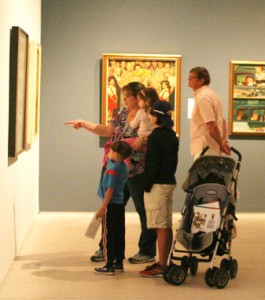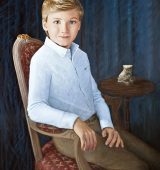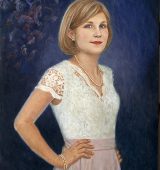As a realistic oil portrait artist, I was  thrilled to hear that the work of my cousin Norman Rockwell was being exhibited close by at the Tampa Museum of Art. This Norman Rockwell traveling exhibit showcased his work from when he was 20 till he was 76—that’s 56 years!
thrilled to hear that the work of my cousin Norman Rockwell was being exhibited close by at the Tampa Museum of Art. This Norman Rockwell traveling exhibit showcased his work from when he was 20 till he was 76—that’s 56 years!
Called “American Chronicles, The Art of Norman Rockwell”, it started by touching on the earliest paintings that were done for stories in Boys’ Life magazine about Daniel Boone when he worked exclusively for the Boy Scouts. Then as he got larger commissions he still supported them by painting their yearly calendar for 60 years. They awarded him the highest Boy Scouts of America award, the Silver Buffalo, in 1939.
In 1916 at age 22, he started working in his most well-known position, that of painting 323 covers for the Saturday Evening Post magazine—until 1963 (47 years). He began by telling humorous stories that were looked forward to each week as part of mainline American entertainment before era of television. He became world famous for idealizing heartfelt sentiments that were viewed by the rest of the planet as what it must be like to live in America. Viewers at the exhibit got to look at the brush strokes of many of these original paintings as well as a whole room dedicated to all the actual printed magazine covers.
Advertisers also capitalized on his popularity. I saw a painting for Raybestos, a brake parts company, in 1922, which is titled “I’m Thinking About My Kiddie.” It shows a pretty young mother at the wheel of her car with her arm around her 6-8-year-old little girl. There were another 4 examples from Kellogg Company who hired him in 1954 to enhance their cereal boxes with paintings of unmistakenly “Rockwellian” children showing off with spoonfuls of cornflakes.
In the late 1930’s, Rockwell’s Post covers and other work became more oriented to current events. As he painted during the war years he documented upbeat and even humorous aspects of proud Americans at home as they backed up the war efforts abroad. He also directly helped to raise money for U.S. War Bonds through his paintings used for posters.
His later works had more serious subjects: civil rights, school desegregation, the Peace Corps, poverty and space exploration. On display was the famous painting showing 6-year-old Ruby Bridges enroute to integrate an all-white school. He was also commissioned to paint oil portraits of 4 presidents: Eisenhower, Kennedy, Johnson and Nixon, 2 of which were exhibited.
In 1977, the year before Norman Rockwell passed away at the age of 84, President Gerald R. Ford awarded him the highest peacetime honor in the U.S., the Presidential Medal of Freedom for “vivid and affectionate portraits of our country” portraying “the American scene with unrivalled freshness and clarity” and with “insight, optimism and good humor.”
Related Posts:
• Comparative Painting Procedures of Norman Rockwell and Jessica Rockwell
• My Cousin Norman Rockwell
• Norman Rockwell’s Legacy
















